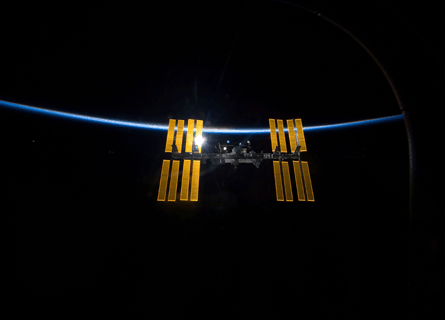The International Space Station has reached a milestone with the 29 May arrival, via a Soyuz TMA-15 launch from Kazakhstan, of the second half of its first-ever six-strong crew.
Doubling the orbiting outpost's complement has been hailed as a step change in the station's usefulness for conducting scientific research, and the current ISS Expedition 20 crew - new arrivals Roman Romenenko (Russia), Robert Thirsk (Canada) and Franke De Winne (European Space Agency) joining Gennady Padalka (Russia), Michael Barratt (USA) and Koichi Wakata (Japan) - has six months on station.
But enthusiasts for the station's scientific capabilities will be keeping a wary eye on logistics, because while keeping six astronauts aboard the ISS at all times will be possible barring a major launch failure, the cargo supply schedule is challenging.
 |
|---|
© NASAISS after STS119 |
Launch and return of astronauts, their critical supplies and spare parts for the station must take priority, so scientific supplies and equipment - and particularly any biological experiments - will face limitations after the Space Shuttle's retirement next year. "Capacity is always going to be a challenge," says ESA acting ISS programme manager Bernardo Patti.
| Cargo Deliveries
SOURCE: NASA *Final Space Shuttle resupply flight |
Each crew member needs about 6kg (13lb) of supplies each day, giving a total of 13,100kg for a team of six for a year. The total annual capacity, without the Space Shuttle, for drinking water and dry cargo, which includes food, equipment and other consumables, is 15,400kg out of a total capability of 22,360kg.
This assumes four Russian Progress resupply vehicle flights and one H-IIB Transfer Vehicle (HTV) and one Automated Transfer Vehicle (ATV) delivery. This will take place in 2011 after the Shuttle will make its final supply flights in 2010.
The Shuttle itself provides water, its multipurpose logistics module (MPLM) can deliver 9,400kg, and the orbiter can take that same quantity back down.
All this is lost with the Shuttle's retirement along with 37,600kg of annual resupply capacity, assuming four MPLM flights. Another lost capability is delivering large spare parts that do not fit into the ATV or HTV using the orbiter's payload bay.
Inadequate spare capacity for parts will be station's Achilles heel. Patti expects future cargo manifests to be chosen through a risk assessment of what spares are needed and what science needs to be done, but "if there is a big subsystem failure" then fewer experiments will be flown, he says.
A criticism of the ISS has been that with three crew, too much time was spent maintaining station and not enough on science. Now there is more crew, but perhaps insufficient laboratory supplies. One solution being considered by NASA is using an MPLM permanently docked with the ISS to hold more spares.
NASA's Commercial Orbital Transportation Services and Commercial Resupply Services (CRS) programme participants Space Exploration Technologies and Orbital Sciences are aiming to provide resupply from 2011. Orbital's Cygnus can deliver 2,600kg and is contracted for eight flights. SpaceX's deal is for 12 flights and Dragon has room for 3,000kg along with an unpressurised 14m3 (150ft3) trunk for 3,000kg more.
After the Shuttle, the station's downmass capability shrinks from the MPLM's 9,400kg to the Soyuz crew spacecraft's 50kg. But SpaceX's Dragon could provide 3,000kg of downmass and Orbital's Cygnus 1,200kg.
 |
|---|
© NASAStation supplies will be tight without Shuttle MPLM deliveries |
The immediate resupply test comes in five months. While ESA's ATV supplied ISS in 2008, in September the Japan Aerospace Exploration Agency's HTV makes its first flight. Loss of that HTV would mean a 25% cargo capacity crunch that would last for years.
Source: Flight International






















